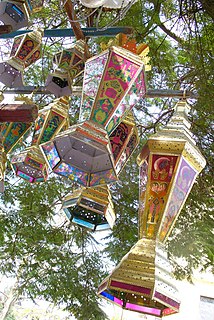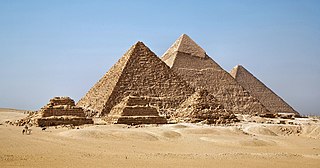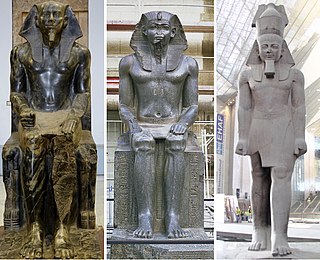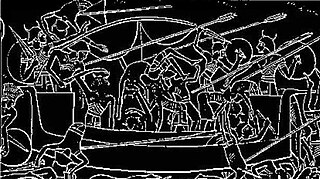 W
WThe history of ancient Egypt spans the period from the early prehistoric settlements of the northern Nile valley to the Roman conquest of Egypt in 30 BC. The pharaonic period, the period in which Egypt was ruled by a pharaoh, is dated from the 32nd century BC, when Upper and Lower Egypt were unified, until the country fell under Macedonian rule in 332 BC.
 W
WThe following outline is provided as an overview of a topical guide to ancient Egypt:
 W
WAncient Egypt was a civilization of ancient North Africa, concentrated along the lower reaches of the Nile River, situated in the place that is now the country Egypt. Ancient Egyptian civilization followed prehistoric Egypt and coalesced around 3100 BC with the political unification of Upper and Lower Egypt under Menes. The history of ancient Egypt occurred as a series of stable kingdoms, separated by periods of relative instability known as Intermediate Periods: the Old Kingdom of the Early Bronze Age, the Middle Kingdom of the Middle Bronze Age and the New Kingdom of the Late Bronze Age.
 W
WThe civilization of ancient Egypt was indebted to the Nile River and its dependable seasonal flooding. The river's predictability and fertile soil allowed the Egyptians to build an empire on the basis of great agricultural wealth. Egyptians are credited as being one of the first groups of people to practice agriculture on a large scale. This was possible because of the ingenuity of the Egyptians as they developed basin irrigation. Their farming practices allowed them to grow staple food crops, especially grains such as wheat and barley, and industrial crops, such as flax and papyrus.
 W
WThe Assyrian conquest of Egypt covered a relatively short period of the Neo-Assyrian Empire from 677 BCE to 663 BCE.
 W
WThe ancient Egyptians regarded beauty as a sign of holiness. Everything they used had a spiritual aspect to it, including cosmetics. Both men and women wore makeup. Traders traded makeup often, especially in the upper classes. In tombs, cosmetic palettes were found buried in gold with the deceased as grave goods, which further emphasized the idea that cosmetics were not only used for aesthetic purposes but rather magical and religious purposes.
 W
WA bident is a two-pronged implement resembling a pitchfork. In classical mythology, the bident is a weapon associated with Hades (Pluto), the ruler of the underworld. Likewise, the three-pronged trident is the implement of his brother Poseidon (Neptune), god of the seas and earthquakes, and the lightning bolt, which superficially looks as if it has one prong, is a symbol of Zeus.
 W
WCemetery GIS is a necropolis in the Giza Plateau. It derives its name from its proximity to pyramid G I (Khufu). The tombs are located on the south side of that pyramid and hence the name G I South Cemetery. Reisner thought the cemetery a continuation of the G7000 cemetery which is part of the Giza East Field. The construction postdates that of mastaba G 7070 of Sneferukhaf. Junker dated the cemetery to the reign of Menkaure based on the presence of granite powder thought to derive from the dressing of the second pyramid at Giza. Reisner allows for a possible construction date dating to the reign of Khafre.
 W
WEgyptian blue, also known as calcium copper silicate (CaCuSi4O10 or CaOCuO(SiO2)4 (calcium copper tetrasilicate)) or cuprorivaite, is a pigment that was used in ancient Egypt for thousands of years. It is considered to be the first synthetic pigment. It was known to the Romans by the name caeruleum. After the Roman era, Egyptian blue fell from use and, thereafter, the manner of its creation was forgotten. In modern times, scientists have been able to analyze its chemistry and reconstruct how to make it. However, Raphael apparently also rediscovered it and used it in his Triumph of Galatea.
 W
WAn Egyptian egg oven or Egyptian mamal is an oven for hatching eggs by incubation using artificial heat. Manmade hatching ovens in Egypt date back to the 4th century BC. They are considered the oldest manmade incubators in the world, and are featured in ancient Egyptian art. Although using old processing methods, they were considered effective at hatching chickens, especially in comparison to other techniques of the time. They were also considered important to the ancient Egyptian agriculture.
 W
WEgyptian finger and toe stalls are pieces of gold jewelry used to protect digits during burial. Such stalls were used during the 18th Dynasty of Egypt, and were thought to protect the deceased from magical dangers. Toe stalls were discovered in the tomb of Tutankhamun, and a nearly complete set of finger and toe stalls was discovered in the tomb of one of the wives of Thutmose III in Thebes. The wives' jewelry is currently on display at the Metropolitan Museum of Art.
 W
WThe Egyptian–Hittite peace treaty, also known as the Eternal Treaty or the Silver Treaty, is the only Ancient Near Eastern treaty for which the versions of both sides have survived. It is also the earliest known surviving peace treaty. It is sometimes called the Treaty of Kadesh, after the well-documented Battle of Kadesh that had been fought some 16 years earlier, although Kadesh is not mentioned in the text. Both sides of the treaty have been the subject of intensive scholarly study. The treaty itself did not bring about a peace; in fact, "an atmosphere of enmity between Hatti and Egypt lasted many years" until the eventual treaty of alliance was signed.
 W
WFanous or Fanoos, also widely known as Fanous Ramadan, is a folk and traditional lantern used to decorate streets and homes in the month of Ramadan. With their origins in Egypt, they have since spread across the Muslim world and are a common symbol associated with the holy month.
 W
WThe Festival Songs of Isis and Nephthys are a work of ancient Egyptian literature whose author is unknown. Probably not older than the Twenty-sixth Dynasty, the songs form part of the funeral hieratic papyrus of Nesi Ámsu. The title is “The Verses of the Festival of the two Zerti,” and the papyrus tells us it was to be sung by two virgins in the temple of Osiris on the occasion of the annual festival held for five days in the fourth month of the sowing season. The verses concern the killing of Osiris by Set, and the later reconstruction of Osiris' body by the goddesses Isis and Nephthys. There is evidence in the text that other copies existed, and that it was old enough to allow of variant readings having crept in. With the “Litanies of Seker,” which follows, consisting of four columns, it occupies twenty-one of the thirty-three columns of the whole papyrus. The second composition which was evidently intended to be sung after the Festival Verses, consists of three parts: I. A Litany to the Sun-God; II. A Recitation by Isis; III. A Litany to the Hathors. During the sixteen repetitions of it which were required, it was to have an accompaniment of tambourines.
 W
WThe gardens of ancient Egypt probably began as simple fruit orchards and vegetable gardens, irrigated with water from the Nile. Gradually as the country became richer, they evolved into pleasure gardens with flowers, ponds and valleys of fruit and shade trees. Temples, palaces, and private residences had their own gardens, and models of gardens were sometimes placed in tombs so their owners could enjoy them in their afterlife.
 W
WThe East Field is located to the east of the Great Pyramid of Giza and contains cemetery G 7000. This cemetery was a burial place for some of the family members of Khufu. The cemetery also includes mastabas from tenants and priests of the pyramids dated to the 5th and 6th Dynasty.
 W
WThe West Field is located on the Giza Plateau, to the west of the Great Pyramid of Giza. It is divided up into smaller areas like the cemeteries known as the Abu Bakr Excavations, as well as several cemeteries whose toponyms are based on the mastaba numbers such as Cemetery G 1000 and Cemetery G 1100. The West Field contains Cemetery G1000 – Cemetery G1600, and Cemetery G 1900. Further cemeteries in this field are: Cemeteries G 2000, G 2200, G 2500, G 3000, G 4000, and G 6000. Three other cemeteries are named after their excavators: Junker Cemetery West, Junker Cemetery East and Steindorff Cemetery.
 W
WThe Hermetica are the philosophical texts attributed to the legendary Hellenistic figure Hermes Trismegistus. These texts may vary widely in content and purpose, but are usually subdivided into two main categories:The "technical" Hermetica: this category contains treatises dealing with astrology, medicine and pharmacology, alchemy, and magic, the oldest of which were written in Greek and may go back as far as to the second or third century BCE. Many of the texts belonging to this category were later translated into Arabic and Latin, often being extensively revised and expanded throughout the centuries. Some of them were also originally written in Arabic, though in many cases their status as an original work or translation remains unclear. These Arabic and Latin Hermetic texts were widely copied throughout the Middle Ages. The "philosophical" Hermetica: this category contains religio-philosophical treatises which were mostly written in the second and third centuries CE, though the very earliest of them may go back to the first century CE. They are chiefly focused on the relationship between human beings, the cosmos, and God, and on moral exhortations calling for a way of life leading to spiritual rebirth, and eventually to apotheosis in the form of a heavenly ascent. The treatises in this category were probably all originally written in Greek, even though some of them only survive in Coptic, Armenian, or Latin translations. During the Middle Ages, most of them were only accessible to Byzantine scholars, until a compilation of Greek Hermetic treatises known as the Corpus Hermeticum was translated into Latin by the Renaissance scholars Marsilio Ficino (1433–1499) and Lodovico Lazzarelli (1447–1500).
 W
WThe history of Persian Egypt is divided into three eras:Achaemenid Egypt, referring to two periods of Achaemenid rule punctuated by an interval of independence: Twenty-seventh Dynasty of Egypt, also known as the First Egyptian Satrapy. Thirty-first Dynasty of Egypt, also known as the Second Egyptian Satrapy. Sasanian Egypt, referring to a period of occupation by the Sasanian Empire, after the Sasanian conquest of Egypt and shortly before the Muslim invasions
 W
WIn ancient Egypt, the term house of eternity refers to a tomb that consists of a pit, a tomb shaft, or from mudbricks, which were later carved into rocks; or built on open land. Burial sites made of stone were a "sign of immortality", due to the long durability of stone. This was an ideal construction method that could be afforded by only a very few ancient Egyptians, due to its high cost. In ancient Egyptian mythology, the construction of a monument during one's own lifetime represented the most intensive representation with the connection of life; and the concept of living in the afterlife.
 W
WA mastaba or pr-djt is a type of ancient Egyptian tomb in the form of a flat-roofed, rectangular structure with inward sloping sides, constructed out of mudbricks. These edifices marked the burial sites of many eminent Egyptians during Egypt's Early Dynastic Period and Old Kingdom. In the Old Kingdom epoch, local kings began to be buried in pyramids instead of in mastabas, although non-royal use of mastabas continued for over a thousand years. Egyptologists call these tombs mastaba, from the Arabic word مصطبة (maṣṭaba) "stone bench".
 W
WMersa Gawasis is a small Egyptian harbour on the Red Sea and a former Egyptian port city. The harbour lies at the mouth of Wadi Gawasis, 2 km south of the mouth of Wadi Gasus. 25 km north is the city of Safaga and 50 km south al-Qusair. mersa gawasis coordinates The place was apparently used as a port in the reigns of Senusret I to Amenemhat IV of the 12th Dynasty, and served as a loading point for expeditions to Punt. The harbour was also a starting point for journeys to the mines of Sinai.
 W
WMusic has been an integral part of Egyptian culture since antiquity in Egypt. Egyptian music had a significant impact on the development of ancient Greek music, and via the Greeks it was important to early European music well into the Middle Ages. Due to the thousands of years long dominance of Egypt over its neighbors, Egyptian culture, including music and musical instruments, was very influential in the surrounding regions; for instance, the instruments claimed in the Bible to have been played by the ancient Hebrews are all Egyptian instruments as established by Egyptian archaeology. Egyptian modern music is considered as a main core of Middle Eastern and Oriental music as it has a huge influence on the region due to the popularity and huge influence of Egyptian cinema and music industries, owing to the political influence Egypt has on its neighboring countries, as well as Egypt producing the most accomplished musicians and composers in the region, specially in the 20th century, a lot of them are of international stature. The tonal structure music in the East is defined by the maqamat, loosely similar to the Western modes, while the rhythm in the East is governed by the iqa'at, standard rhythmic modes formed by combinations of accented and unaccented beats and rests.
 W
WThe Neo-Assyrian Empire was an Iron Age Mesopotamian empire, in existence between 911 and 609 BC, and became the largest empire of the world up until that time. The Assyrians perfected early techniques of imperial rule, many of which became standard in later empires. The Assyrians were the first to be armed with iron weapons, and their troops employed advanced, effective military tactics.
 W
WThe Nile River is a major resource for the people living along it, especially thousands of years ago. The El Salha Archaeological Project discovered an abundance of evidence of an ancient boat that traveled the Nile River dating back to 3,000 years ago. Pictographs and pebble carvings were uncovered, indicating a boat more advanced than a simple canoe. This evidence of a progressed Nile boat includes a steering system which may have been used in the Nile for fishing and transportation.
 W
WHyksos is a term which, in modern Egyptology, designates the kings of the Fifteenth Dynasty of Egypt. The seat of power of these kings was the city of Avaris in the Nile delta, from where they ruled over Lower and Middle Egypt up to Cusae. In the Aegyptiaca, a history of Egypt written by the Greco-Egyptian priest and historian Manetho in the 3rd century BC, the term Hyksos is used ethnically to designate people of probable West Semitic, Levantine origin. While Manetho portrayed the Hyksos as invaders and oppressors, this interpretation is questioned in modern Egyptology. Instead, Hyksos rule might have been preceded by groups of Canaanite peoples who gradually settled in the Nile delta from the end of the Twelfth Dynasty onwards and who may have seceded from the crumbling and unstable Egyptian control at some point during the Thirteenth Dynasty.
 W
WOvis longipes palaeo-aegyptiacus is a type of the extinct wild barbary sheep found in the ancient Southern Egypt and Nubia. The ovacaprines were domesticated and often depicted on the stone tomb murals of the pharaohs for religious or aesthetic purposes. Ovis longipes palaeo-aegyptiacus was one of the two most commonly domesticated sheep utilized on the reliefs of early pharaonic tombs mostly because of its unique loosely spiraling horns which came out of the sides of the skull. A similar form of the sheep called Ovis platyura aegyptiaca had horns that developed downward and curled forward.
 W
WThe periodization of ancient Egypt is the use of periodization to organize the 3,000-year history of ancient Egypt. The system of 30 dynasties recorded by third-century BC Greek-speaking Egyptian priest Manetho is still in use today ; however, the system of "periods" and "kingdoms" used to group the dynasties is of modern origin. The modern system consists of three "Golden Ages", interspersed between "intermediate periods" and early and late periods.
 W
WThe Sea Peoples are a purported seafaring confederation that attacked ancient Egypt and other regions of the East Mediterranean prior to and during the Late Bronze Age collapse. Following the creation of the concept in the nineteenth century, it became one of the most famous chapters of Egyptian history, given its connection with, in the words of Wilhelm Max Müller: "the most important questions of ethnography and the primitive history of classic nations". Their origins undocumented, the various Sea Peoples have been proposed to have originated from places that include western Asia Minor, the Aegean, the Mediterranean islands and Southern Europe. Although the archaeological inscriptions do not include reference to a migration, the Sea Peoples are conjectured to have sailed around the eastern Mediterranean and invaded Anatolia, Syria, Phoenicia, Canaan, Cyprus and Egypt toward the end of the Bronze Age.
 W
WSebakh is an Arabic word that translates to "fertilizer". In English, the term is primarily used to describe decomposed mudbricks from archaeological sites, which is an organic material that can be employed both as an agricultural fertilizer and as a fuel for fires.
 W
WThe shendyt was a kilt-like garment worn in ancient Egypt. It was made of cloth and was worn around the waist, typically extending to above the knees. Shendyts are depicted on pharaohs, deities, and commoners in a variety of situations in Egyptian artwork.
 W
WThe Sherden are one of the several ethnic groups the Sea Peoples were said to be composed of, appearing in fragmentary historical and iconographic records from the eastern Mediterranean in the late 2nd millennium BC.
 W
WThe simsimiyya is an indigenous Egyptian stringed instrument that has its roots in ancient Egypt. It is used in Egypt in certain genres of Egyptian music.
 W
WUronarti, a Nubian word meaning "Island of the King", is an island in the Nile just south of the Second Cataract in the north of Sudan. The primary importance of the island lies in the massive ancient fortress that still stands on its northern end. This fortress is one of a number constructed along the Nile in Lower Nubia during the Middle Kingdom, primarily by the rulers Senusret I and Senusret III.
 W
WWah-Sut is a town located south of Abydos in Middle Egypt. The name of the town indicates that it was originally built as an outlying part of Abydos, set up by the Egyptian state as housing for the people working in and around the funerary complex of pharaoh Senusret III of the Twelfth Dynasty, at the peak of the Middle Kingdom.
 W
WAncient Egypt was a civilization of ancient North Africa, concentrated along the lower reaches of the Nile River, situated in the place that is now the country Egypt. Ancient Egyptian civilization followed prehistoric Egypt and coalesced around 3100 BC with the political unification of Upper and Lower Egypt under Menes. The history of ancient Egypt occurred as a series of stable kingdoms, separated by periods of relative instability known as Intermediate Periods: the Old Kingdom of the Early Bronze Age, the Middle Kingdom of the Middle Bronze Age and the New Kingdom of the Late Bronze Age.
 W
WWooden tomb models were deposited as grave goods in the tombs and burial shafts in Middle Kingdom. They included a wide variety of wooden figurines and scenes, such as boats, granaries, baking and brewing scenes and butchery scenes.
 W
W